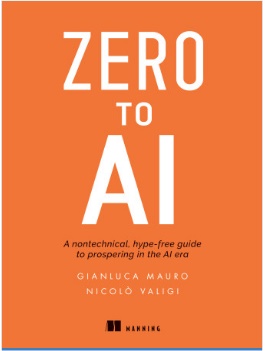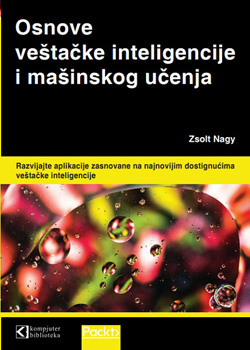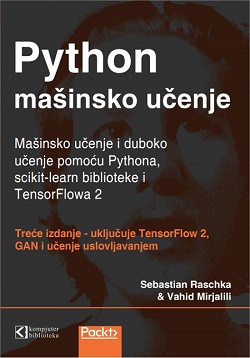
Autor:
Broj strana: 264
ISBN broj: 9781617296062
Izdavač:
MANNING PUBLICATIONS ![]()
Godina izdanja: 2020.
 |
 |
 |
 |
 |
||||
The best book, currently, on realistic AI applications: factual, accurate, and hype-free. Alain Couniot, Sopra Steria Benelux How can artificial intelligence transform your business? In Zero to AI, you’ll explore a variety of practical AI applications you can use to improve customer experiences, optimize marketing, help you cut costs, and more. In this engaging guide written for business leaders and technology pros alike, authors and AI experts Nicolò Valigi and Gianluca Mauro use fascinating projects, hands-on activities, and real-world explanations to make it clear how your business can benefit from AI.
There’s no doubt that artificial intelligence has made some impressive headlines recently, from besting chess and Go grand masters to producing uncanny deep fakes that blur the lines of reality. But what can AI do for you? If you want to understand how AI will impact your business before you invest your time and money, this book is for you.
Zero to AI uses clear examples and jargon-free explanations to show the practical benefits of AI. Each chapter explores a real-world case study demonstrating how companies like Google and Netflix use AI to shape their industries. You begin at the beginning, with a primer on core AI concepts and realistic business outcomes. To help you prepare for the transition, the book breaks down a successful AI implementation, including advice on hiring the right team and making decisions about resources, risks, and costs.
1.1 The path to modern AI
1.2 The engine of the AI revolution: machine learning
1.3 What is artificial intelligence, after all?
1.4 Our teaching method
Summary
Part 1: Understanding AI
2.1 Unleashing AI on core business data
2.2 Using AI with core business data
2.2.1 The real estate marketplace example
2.2.2 Adding AI capabilities to FutureHouse
2.2.3 The machine learning advantage
2.2.4 Applying AI to general core business data
2.3 Case studies
2.3.1 How Google used AI to cut its energy bill
2.3.2 How Square used AI to lend billions to small businesses
2.3.3 Case studies lessons
2.4 Evaluating performance and risk
Summary
3.1 Why AI for sales and marketing
3.2 Predicting churning customers
3.3 Using AI to boost conversion rates and upselling
3.4 Performing automated customer segmentation
3.4.1 Unsupervised learning (or clustering)
3.4.2 Unsupervised learning for customer segmentation
3.5 Measuring performance
3.5.1 Classification algorithms
3.5.2 Clustering algorithms
3.6 Tying ML metrics to business outcomes and risks
3.7 Case studies
3.7.1 AI to refine targeting and positioning: Opower
3.7.2 AI to anticipate customer needs: Target
Summary
4.1 Improving products with computer vision
4.2 Using AI for image classification: deep learning?
4.3 Using transfer learning with small datasets
4.4 Face recognition: teaching computers to recognize people
4.5 Using content generation and style transfer
4.6 What to watch out for
4.7 AI for audio
4.8 Case study: optimizing agriculture with deep learning
4.8.1 Case questions
4.8.2 Case discussion
Summary
5.1 The allure of natural language understanding
5.2 Breaking down NLP: Measuring complexity
5.3 Adding NLP capabilities to your organization
5.3.1 Sentiment analysis
5.3.2 From sentiment analysis to text classification
5.3.3 Scoping a NLP classification project
5.3.4 Document search
5.3.5 Natural conversation
5.3.6 Designing products that overcome technology limitations
5.4 Case study: Translated
5.4.1 Case questions
5.4.2 Case discussion
Summary
6.1 The curse of choice
6.2 Driving engagement with recommender systems
6.2.1 Content-based systems beyond simple features
6.2.2 The limitations of features and similarity
6.3 The wisdom of crowds: collaborative filtering
6.4 Recommendations gone wrong
6.4.1 The recommender system dream
6.5 Case study: Netflix saves $1 billion a year
6.5.1 Netflix’s recommender system
6.5.2 Recommendations and user experience
6.5.3 The business value of recommendations
6.5.4 Case questions
6.5.5 Case discussion
Summary
Part 2: Building AI
7.1 Don’t fall for the hype: Business-driven AI innovation
7.2 Invention: Scouting for AI opportunities
7.3 Prioritization: Evaluating AI projects
7.4 Validation: Analyzing risks
7.5 Deconstructing an AI product
7.6 Translating an AI project into ML-friendly terms
7.7 Exercises
7.7.1 Improving customer targeting
7.7.2 Automating industrial processes
7.7.3 Helping customers choose content
Summary
8.1 Data strategy
8.1.1 Where do I get data?
8.1.2 How much data do I need?
8.2 Data quality
8.3 Recruiting an AI team
Summary
9.1 Buying or building AI
9.1.1 The Buy option: Turnkey solutions
9.1.2 The Borrow option: ML platforms
9.1.3 The Build option: Roll up your sleeves
9.2 Using the Lean Strategy
9.2.1 Starting from Buy solutions
9.2.2 Moving up to Borrow solutions
9.2.3 Doing things yourself: Build solutions
9.3 Understanding the virtuous cycle of AI
9.4 Managing AI projects
9.5 When AI fails
9.5.1 Anki
9.5.2 Lighthouse AI
9.5.3 IBM Watson in Oncology
9.5.4 Emotional diary
9.5.5 Angry phone calls
9.5.6 Underperforming sales
Summary
10.1 How AI threatens society
10.1.1 Bias and fairness
10.1.2 AI and jobs
10.1.3 The AI filter bubble
10.1.4 When AI fails: Corner cases and adversarial attacks
10.1.5 When the artificial looks real: AI-generated fake content
10.2 Opportunities for AI in society
10.2.1 Democratization of technology
10.2.2 Massive scale
10.3 Opportunities for AI in industries
10.3.1 Social media networks
10.3.2 Health care
10.3.3 Energy
10.3.4 Manufacturing
10.3.5 Finance
10.3.6 Education
10.4 What about general AI?
10.5 Closing thoughts
Summary
Identifying where AI can help your organization Designing an AI strategy Evaluating project scope and business impact Using AI to boost conversion rates, curate content, and analyze feedback Understanding how modern AI works and what it can/can’t do
For anyone who wants to gain an understanding of practical artificial intelligence and learn how to design and develop projects with high business impact.
Gianluca Mauro and Nicolò Valigi are the cofounders of AI Academy, a company specializing in AI trainings and consulting.
Budite prvi koji će ostaviti komentar.

Popust cena:
1840.00 rsd

Popust cena:
2640.00 rsd
© Sva prava pridržana, Kompjuter biblioteka, Beograd, Obalskih radnika 4a, Telefon: +381 11 252 0 272 |
||